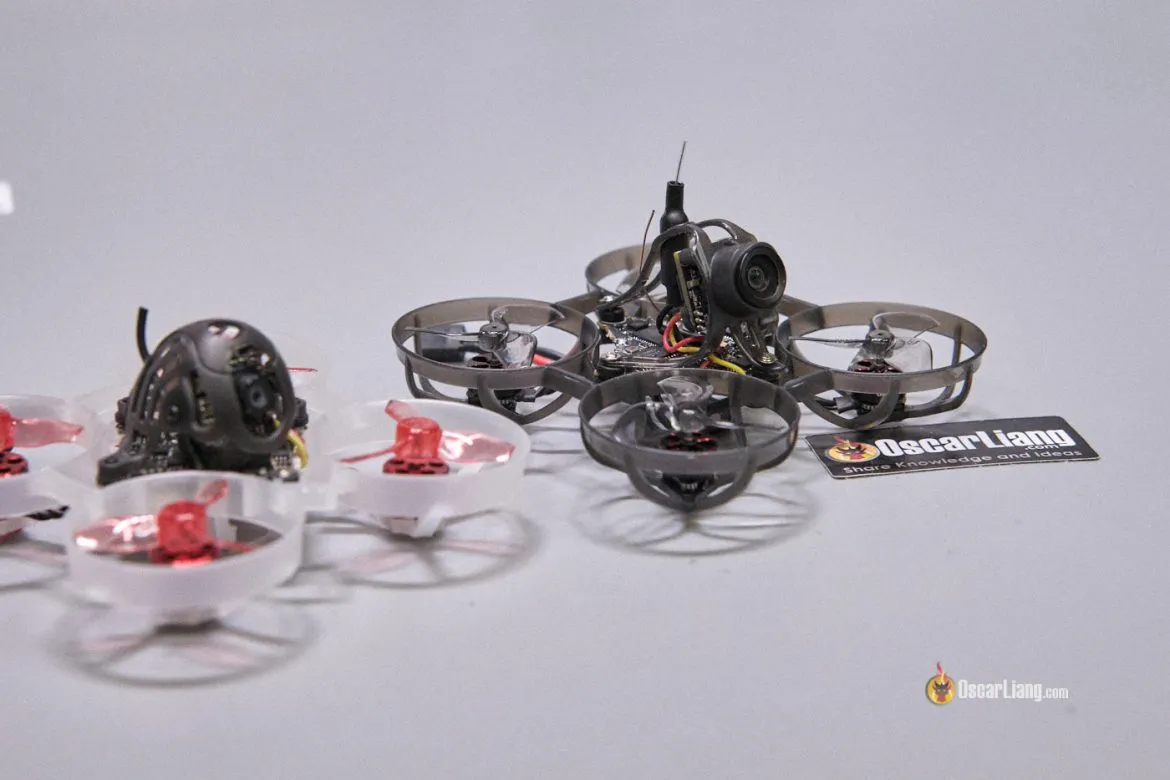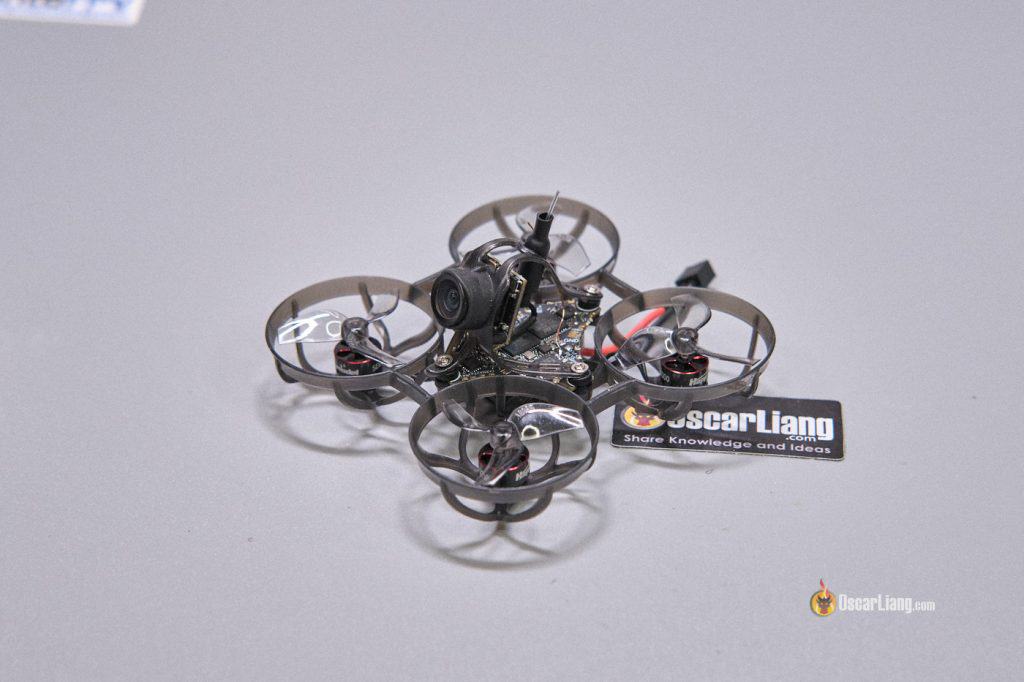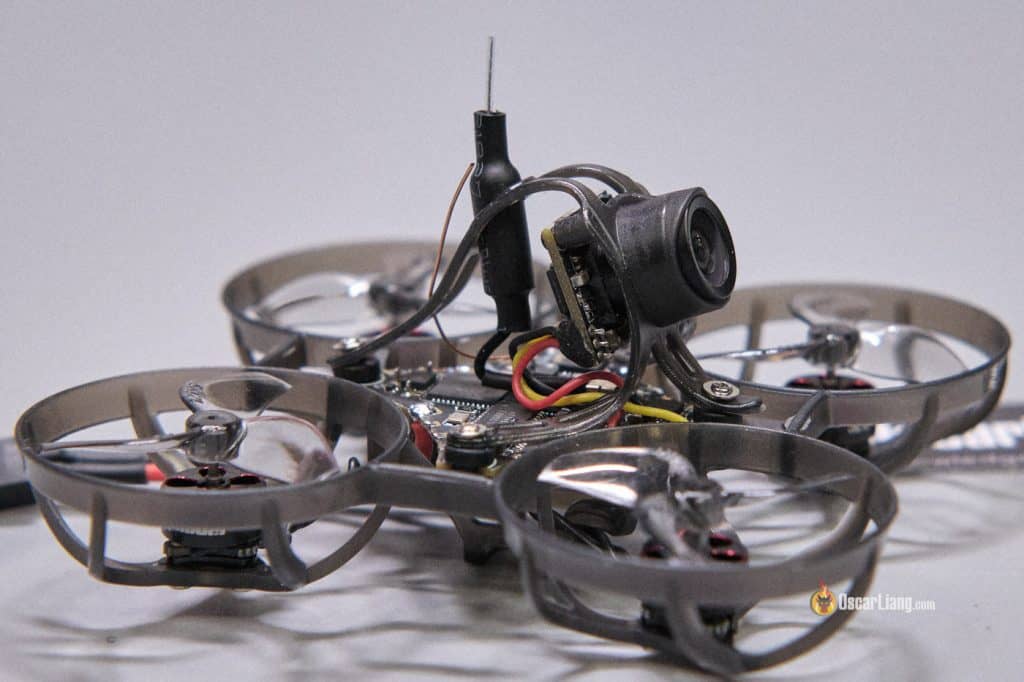The Happymodel Mobula6 2024 edition might just be the best BNF Tiny Whoop this year. As someone who has tested many micros, including previous versions of the Mobula, I was eager to see how this one stacked up, especially in terms of flight performance and durability.
If you’re new to Tiny Whoops, check out our buyer’s guide for useful accessories, spare parts, and tips: https://oscarliang.com/best-tiny-whoop/
Table of Contents
Where to Buy?
Get the Mobula6 2024 Edition from these vendors:
- Banggood: https://oscarliang.com/product-4wip
- AliExpress: https://s.click.aliexpress.com/e/_DEGydSx
- GetFPV: https://oscarliang.com/product-htbt
- Amazon: https://amzn.to/4aMTaVP
Batteries are not included, get them here (A30 connectors): https://oscarliang.com/best-tiny-whoop/#Best-A30-BT20-Batteries
Specifications
Frame
- Size: 81mm x 81mm x 37mm
- Brand Name: Happymodel
- Wheelbase: 65mm
Flight Controller
- Built-in current meter sensor: Current meter scale 1175
- Built-in voltage meter sensor: Voltage meter scale 110
- Power supply: 1-2S battery input (DC 2.9V-4.35V)
- MCU: STM32F411CEU6 (100MHz, 512K FLASH)
- Built-in 5A (each): Blheli_S 4in1 ESC
- Mount hole size: 25.5mm x 25.5mm
- Built-in UART ExpressLRS: V3.0.0
Onboard 4-in-1 ESC
- Current: 6A continuous, peak 12A (3 seconds)
- Factory firmware: Bluejay ESC V0.19.2
- Support: BLHeli_S Programmable
- Power supply: 1-2S LiPo/LiPo HV
- Default protocol: DSHOT300
Motors
- Motor Dimensions (Dia. x Len): 9.5mm x 14mm
- Model: SE0702 KV28000
- Stator Diameter: 7mm
- Configuration: 9N12P
- Shaft Diameter: 1mm
- No. of Cells (Lipo): 1S
- Stator Length: 2mm
- Weight: 1.46g
Design and Durability
The Mobula6 2024 is incredibly lightweight, tipping the scales at just over 17.8 grams. Compared to the original Mobula6, which weighed 20.2 grams, it’s over 10% lighter. This weight reduction is mainly due to a new lightweight frame design, though it might raise concerns about durability.
Personally, I like the idea of using a more stripped-down canopy—this is exactly what the hardcore Tiny Whoop community has wanted for a long time.
I expected the durability of the 2024 Edition to be worse compared to the original version due to the minimal plastic used in the canopy protecting the camera. However, it held up remarkably well after numerous crashes during my test flights. This resilience is likely due to its overall lightweight design.
However, there are weak stress points around the base of the camera mount. After a few days of flying and crashing, the camera mount became a little deformed, causing the camera to tilt slightly to one side. While still flyable, this issue is noticeable when flying and slightly annoying, but fortunately, it comes with a spare canopy in the box.
Despite this, the overall build quality and construction are solid, with a well-thought-out component layout that makes maintenance and repairs straightforward.
Component Upgrades
The Mobula6 2024 Edition features some notable upgrades in its electronics and camera. The new SuperX 5in1 AIO FC board is streamlined and appears well-suited for future frame designs due to its compact size. It has a built-in ExpressLRS receiver with a copper wire antenna, which I found offers better range and durability compared to ceramic antennas.
The camera is another highlight, offering a wider field of view than the previous Nano 3 camera. While the Nano 3 provided clear images, its narrow field of view was limiting. The new camera’s wider FOV is a welcome improvement, enhancing the flying experience by providing a better sense of the drone’s surroundings. However the exposure is a bit on the low side.
It uses A30 battery connector, an upgrade from PH2.0 – see my testing and comparison between these connectors here: https://oscarliang.com/micro-battery-connectors-testing/
Therefore you’ll need batteries with A30 connectors, see my battery recommendations here: https://oscarliang.com/best-tiny-whoop/#Best-A30-BT20-Batteries
Flight Performance
The Mobula6 2024 Edition surprised me with its agility and responsiveness right out of the box. It handles beautifully, even when navigating tight spaces and close to obstacles. Although the stock PID and filter tune seemed to require further tweaking to reduce prop wash and vibration, the overall flight performance was solid.
However, there’s some electrical noise in the FPV feed as soon as you arm the quad, probably some hardware design issue – a sign of lack of filtering. Also make sure to tighten all FC screws otherwise it tends to flyaway on take off for some weird reason.
I get about 3.5 minutes on 1S 300mah LiHV battery, or 3:10 on 260mah. Hovers at 30% throttle when fully charged.
One of the biggest selling points of the Mobula6 is its versatility. Its compact size and quiet operation make it perfect for indoor flying, but it’s also capable outdoors in calm conditions. You don’t need a large space to enjoy flying this drone.
How to Setup
Binding Receiver:
ExpressLRS receiver firmware target in ELRS 3.4 and newer is HappyModel AIO 2.4GHz RX+VTX, under Happymodel device category. In ELRS 3.3 and older, it’s Generic ESP32 2.4Ghz Rx and VTx.
The Betaflight Config is a mess.
BetaFlight Config:
- Chang PID loop frequency to 3.2KHz (not sure why it’s set to 0.8KHz which is unusually low for today’s standard, and unnecessary).
- Change channel map to Default.
- Increase Warning Cell Voltage to 3.2V, current sensor scale from 1175 to 950
- Apply ExpressLRS preset based on your preferred packet rate
- Apply your rates
- Assign switches for Arm, Angle, Beeper and Turtle modes
- disable motor stop
- Motor idle set to 7%
ESC already flashed Bluejay, 0.19, and RPM filter is enabled by default. ESC firmware target is O-H-5.
See this post for the best settings and tips to enhance your Tiny Whoop experience: https://oscarliang.com/best-tinywhoop-settings/
Final Thoughts
The Mobula6 2024 Edition from Happymodel sets a high bar for what a Tiny Whoop can be. Its robust build, lightweight construction, enhanced camera, and improved electronics make it a standout model that should be on every micro drone enthusiast’s radar.
Get the Mobula6 2024 Edition from these vendors:
- Banggood: https://oscarliang.com/product-4wip
- AliExpress: https://s.click.aliexpress.com/e/_DEGydSx
- GetFPV: https://oscarliang.com/product-htbt
However, the weak canopy and camera vulnerability are concerns potential buyers should be aware of. The PID tune also has room for improvement.
There’s some electrical noise in the FPV feed which is a shame – I am not sure if this is just my unit or a wider problem though. Let me know in the comment if you have this issue.
For anyone from beginners to experienced pilots looking to dive into or upgrade their tiny whoop collection, the Mobula 6 2024 edition offers a compelling blend of performance and fun. While it has some flaws, its strengths make it a worthwhile consideration for anyone passionate about drone flying.










15 comments
Hello Oscar, thanks for so much useful information on your website. I recently finished building my first quad based on your how-to article, and I’m in the process of setting up the analog VTX. While doing so, I realized I wanted a Tiny Whoop for indoors, hence this post. My question is, Tiny Whoops seem to come with a vtx system built in, but I can’t seem to find out what protocol each model supports (analog vs. digital). How do I find out? If I were to get “HappyModel Mobula6 2024 1S 65mm Ultra Light Micro FPV Whoop Built-in Serial ELRS 2.4GHz SuperX ELRS 800TVL 400mW 0702 KV28000” would I be able to have it talk to my EV800D?
The model in this review is analog, so it’s compatible with your EV800D.
For tiny whoops, there are currently only two options if they are using digital systems: Walksnail and HDZero. If they are using either of these systems, these names should be mentioned in the product name or specifications, otherwise it’s safe to assume it’s analog.
Hey buddy. Great info as always, but go back and check your FC/esc specs. They conflict. 12a continuous with 6a spike?
Hi Osar, nice post!.
The question now is … What about HDZero Mobula6 ECO 2024?. Which one you pick?.
Thanks!
I don’t fly HDZero at the moment.
I also have this problem with video noise :(
It occurs instantly after arming. Kopterheld shows this problem here: youtu.be/NlW4q-D72kc?feature=shared&t=315 (in german)
Hi Oscar, I have two mob 6 2024s I’m having issues with the video feed when armed on both whoops, this seems to be a common issue with no solutions available on any forums, I’ve tried a different antennas, channels, esc settings in (esc configurator), tune, turning off ADC filter on the controller, replacing the battery cable with betafpv battery lead BT2.0, moving the two antennas apart, different AIO rubbers, motor screws not touching, upgrading elrs, not sure if its a bad voltage regulator on both whoops or something else I’m overlooking? I have other whoops so my goggles are okay.
Any advice on how to fix this would be appreciated
what sort of noise? is it constant or when you throttle up? upload to youtube maybe?
Hi Oscar, it’s perfect before I arm once armed there’s a lot of horizontal wavey lines mostly white and just general break up, compared to other analog quads I have, the throttle position has no effect could it be something to do with the UARTS in the ports tab and the UARTS on the MSP settings or UARTS assigned in my radio? I don’t have a great deal of experience with AIOS with built in VTX’s im just getting into whoops,
Hi Oscar, I have motor noise with white diagonal lines in my video feed on the Mobula6 2024. Do you know anything what can be done against this? Could maybe a capacitor, shortening of the camera wires or a any other change help? Thanks!
Here you can find a video in german where you can see the problem at 5:31
https://www.youtube.com/watch?v=NlW4q-D72kc&t=331s
What do you think of the Meteor 65 and 65 Pro compared to this one?
It’s a solid whoop for sure, but way heavier. And I think it was released 2 years ago?
My camera mount/canopy came out of the box with the bottom edge (near the camera screw) already stressed. I noticed the camera was a bit angled to the side, so I swapped the canopy with the extra. As I was putting everything back together, the new canopy developed the same stress point right below the lower camera screw point. Like you said, it’s not a dealbreaker, but I do notice that it’s not straight.
Besides the canopy issue, this thing is loads of fun. It has so much power for a 65mm, even outside in light wind I wasn’t having any issues keeping control.
absolutely! I think it’s just the particular material they use that has the tendency to deform easily. Maybe 3D printed TPU would be better.